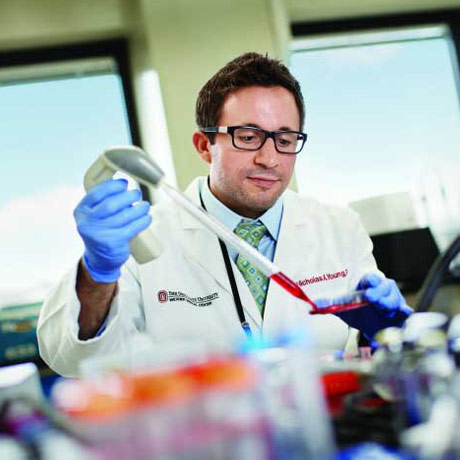Stress moderation impacting lupus with exercise (SMILE)
Using Tai Chi to Explore the Effects of Daily Moderate Exercise and Stress Reduction in Lupus
After results in mouse models suggested that moderate exercise or stress reduction may be potent means to control the chronic inflammation associated with lupus, Nicholas Young, PhD, is translating his findings to the clinic.
Dr. Young is a research scientist in the Division of Rheumatology and Immunology at The Ohio State University Wexner Medical Center, and works in a laboratory led by Wael Jarjour, MD, director of the division. His study will enroll up to 30 patients in a Tai Chi class and track their progress over six months to determine whether inflammatory activity is suppressed. This next phase of research is funded by a pilot grant from Ohio State’s Center for Integrative Health and Wellness and an award from the Rheumatology Research Foundation.
In his previous work, Dr. Young studied the effects of exercise and social stress using mice that spontaneously develop lupus nephritis. He and his team, including Saba Aqel and Jeffrey Hampton, found there was a clear difference in the amount of inflammation and kidney damage in mice that were exercised daily compared to the mice that did not exercise.
Simultaneously, Dr. Young, in collaboration with John Sheridan, PhD, from Ohio State’s Institute of Brain, Behavior and Immunology, and Nicole Powell, PhD, of Ohio Dominican University, examined the effects of social stress on lupus progression in an animal model. Compared to the control pool, the mice who experienced social stress developed significantly higher blood urea nitrogen levels and renal inflammation.
In applying these findings to people, Dr. Young says he chose Tai Chi because it is a form of moderate exercise that also incorporates stress reduction techniques including deep breathing and meditation. With the help of fellow laboratory members Giancarlo Valiente and Holly Steigelman, he will begin recruiting lupus patients once the study is approved by Ohio State’s Institutional Review Board.
“This is just the beginning of research that could have far-reaching potential,” says Dr. Young. “Even though we’re starting with a small number of patients, our goal is to generate pilot data to be able to create a strong NIH grant submission that allows us to continue the study on a much larger scale.”
Dr. Young adds that in exploring the molecular mechanisms by which exercise and social stress are involved in suppressing the inflammatory response, including the impact on pro-inflammatory cytokine levels, it may be possible to determine precisely how and why they are effective. This could allow physicians to prescribe specific exercise or stress management regimens for patients with autoimmune disorders to follow along with their current pharmaceutical therapy.

 Nicholas.Young@osumc.edu
Nicholas.Young@osumc.edu